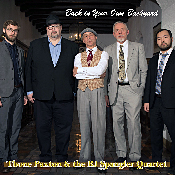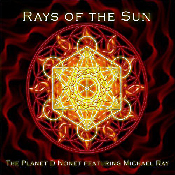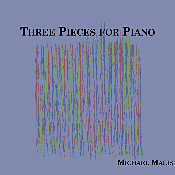Recent Recordings by
Area Jazz Artists
Although the clubs and concert halls have been temporarily silenced, our local musicians can be heard streaming from home or on numerous recordings. Below is a selection of two brand new ones and an older one of note.
As an antidote for the tough times and to shake off the blues, the new recording by Tbone Paxton & the RJ Spangler Quartet, Back in Your Own Backyard (DMF 2020) is the perfect prescription. For this recital, the two long-time friends and musical companions surrounded themselves with a comfortable rotating set of regular colleagues so that although billed as a quartet, the group expands up to an octet. With one exception, the accent is on Paxton’s singing, with occasional dollops of his trombone playing.
The eleven tracks consist of classic but not overworked pre-WW II songs that provide a nice variety of moods and feelings. The opening title track, “C’est Ci Bon,” and Charlie Chaplin’s “Smile” set a relaxed swinging mood, but things get down and a bit dirty with Lowell Fulson’s “Room with a View,” and in the final “Don’t Let the Sun Catch You Crying.”
There is ample room for succinct idiomatic solos by the other members of the group; indeed, since this is Paxton’s first album under his own name, one would have wished that he had featured more of his trombone playing. On the one purely instrumental track, Sidney Bechet’s “Petite Fleur,” done with a Latin rhythm, the spotlight is on Chris Tabaczynski’s imaginative soprano saxophone playing, with only occasional tips of the hat to the style of the great New Orleans musician. After a nicely contrasting electric guitar solo by Matt LaRusso, Paxton finally comes in with a melodic outing on muted trombone and stays in behind the saxophone restatement of the melody.
Here, as throughout, there is little attempt to imitate any classic recording. Rather, the arrangements and the ensemble and solo playing demonstrate an effortless mastery of classic jazz playing, with judicious modern touches, based firmly in swing.
Since we are dealing with RJ Spangler, a musician who feels at home in the whole history of jazz, it is time to make up for an omission. The Update has reviewed many of the numerous works by RJ and his various groups, but one very important recording has not been featured until now.
In 2012 The Planet D Nonet Featuring Michael Ray was recorded in Detroit at Trinosophes playing selections from the immense repertoire of Sun Ra, released on Rays of the Sun (ELD-026). Much like Duke Ellington, Sun Ra wrote for his orchestra and for the sound of his musicians, many of whom spent decades with him. Spangler and Jim O’Donnell, who lead the Nonet, know well that this soundscape cannot and should not be closely reproduced if one is to be faithful to the essence of Ra rather than to academic pedantry and so this music is a reinterpretation driven by the spirit of the master. In this Planet D succeeds immensely, joined for the occasion by trumpeter Ray, who was a mainstay of Sun Ra’s Arkestra from 1978 until the leader left for Saturn and who plays to this day with the band under Marshall Allen’s direction.
This was the second recoding by Planet D of Ra’s music, following on We Travel the Spaceways: The Music of Sun Ra, reviewed in the Update in 2012. For this recital the leaders chose compositions from the sixties and seventies, including two from the 1978 album Laquidity, the first one to feature Ray after he joined Ra. One of these is the opening “Where Pathways Meet,” which establishes the swinging vibe that permeates the whole concert, driven ferociously by the percussion section made up of RJ on drums and Akunda Hollis on the West African djembe drum. Ra wrote a formidable number of compositions over his long career, and Spangler has wisely chosen items with divergent feelings, rhythms, and moods. Up-tempo anthems such as “Pathways” and “Rocket Number Nine” contrast with “That’s How I Feel,” which begins with the out of tempo electric piano of Michael Malis, much longer and more exploratory than what is on the original recording, followed by Ray, but then it falls into a funky groove, featuring more of Ray followed by a long fiery virtuoso tenor outing by Dan Bennet, whose solos provide some of the highlights of the album.
The last two tracks of the concert are set up by the atmospheric a capella bass playing of Trinosophes proprietor Joel Peterson, who then brings in the band on both tracks with powerful riffs. On the final track, recorded a few months earlier, poet, bluesnik, activist, and raconteur John Sinclair recites Sun Ra’s poem “There is a Change in the Air,” in a manner quite different from the 1974 performance preserved on the album Antique Blacks, with less orchestra and a much more powerful and expressive reading than on the original recording.
While the CD contains many wonderful solos, its success is supremely collective—this is a marvelous cohesive band in which the experience and skills of all members blend together, fueled by individual talent, years of common experience, and the leadership of Spangler and O’Donnell. I should note that this is a concert recording made with one microphone in a big space so that the sound is not perfect, but it provides a good flavor of the actual performance, which was a great thrill to hear.
Michael Malis, who was featured on Rays of the Sun, has just released Three Pieces for Piano, a set of compositions just right for our time. Although written six years ago, Mallis decided to make them available because, as he expresses it, “I feel that making art is more important now than ever. We live in strange times, where mandated social distancing is our only hope at defeating a pandemic which could cause irreparable harm. In this moment that we can’t be together physically, life can feel creatively stifling. We have to do what we can to continue to cultivate our sense of community.”
This is atmospheric music that defies category, written in a manner that reflects the influence of various twentieth century classical composers, but is performed in an eloquent style that reveals the pianist’s deep jazz spirit. This is thrilling music, with shifting harmonic and rhythmic qualities that require prodigious precise technique and the kind of generic versatility that few pianists achieve. Each of the three compositions offers a different mood and diverse compositional techniques, marked by judicious self-control as there is no fluff here, digression, or excessive ornamentation.
This is a wonderful milestone in the artistic progress of an artist of boundless versatility and intellectual curiosity secured in an expressiveness anchored in solid artistic discipline. Moreover, purchase of the music includes the composer’s piano scores for those who would like to play or analyze them in detail.


